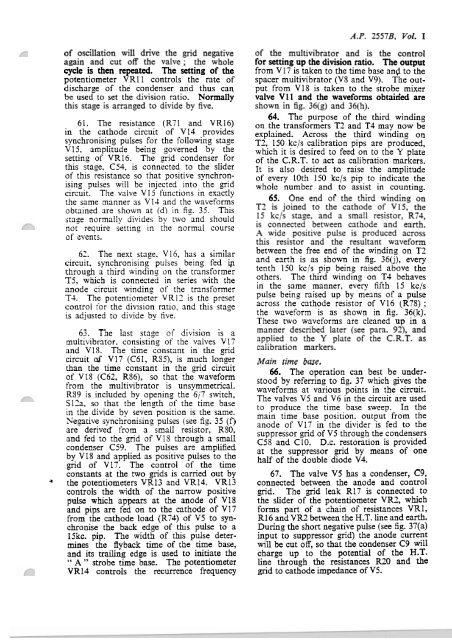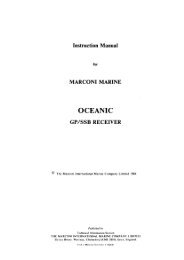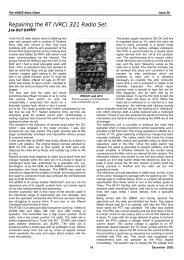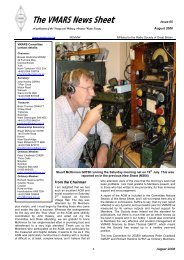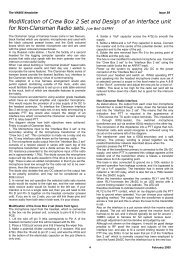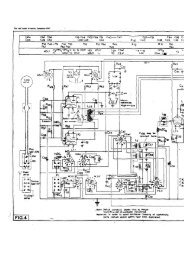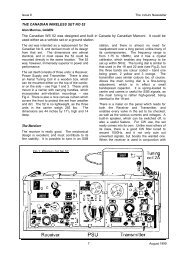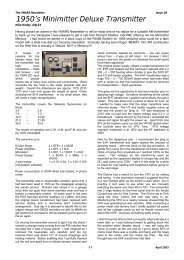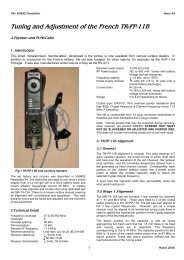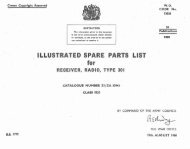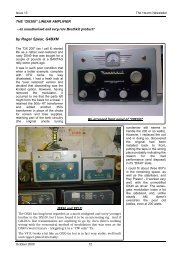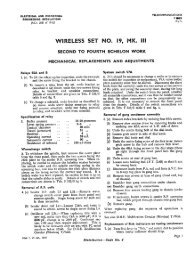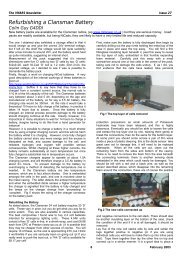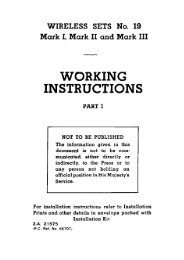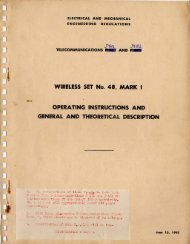2115_ Gee_MkII_Tropical.pdf - VMARSmanuals
2115_ Gee_MkII_Tropical.pdf - VMARSmanuals
2115_ Gee_MkII_Tropical.pdf - VMARSmanuals
You also want an ePaper? Increase the reach of your titles
YUMPU automatically turns print PDFs into web optimized ePapers that Google loves.
A.P. 25578, Vol. I<br />
of oscillation will drive the grid negative of the multivibrator and is the control<br />
again and cut off the valve ; the whole for setting up the division ratio. The output<br />
cycle is then repeated. The setting of the from V17 is taken to the time base and to the<br />
potentiometer VRll controls the rate of spacer multivibrator (VS and V9). The outdischarge<br />
of the condenser and thus can put from V18 is taken to the strobe mixer<br />
be used to set the division ratio. Normally valve V11 and the waveforms obtairied are<br />
this stage is arranged to divide by five. shown in fig. 36(g) and 36(h).<br />
64. The purpose of the third winding<br />
61. The resistance (R71 and VR16) on the transformers T2 and T4 may now be<br />
in the cathode circuit of V14 provides explained. Across the third winding on<br />
synchronising pulses for the following stage<br />
V15, amplitude being governed by the<br />
setting of VR16. The grid condenser for<br />
this stage, C54, is connected to the slider<br />
of this resistance so that positive synchronising<br />
pulses will be injected into the grid<br />
circuit. The valve V15 functions in exactly<br />
the same manner as V13 and the waveforms<br />
obtained are shown at (d) in fig. 35. This<br />
stage normally divides by two and should<br />
not require setting in the normal course<br />
of events.<br />
62. The next stage, V16, has a similar<br />
circuit, synchronising pulses being fed ig<br />
throu& a third winding on the transformer<br />
T5, which is connected in series with the<br />
anode circuit winding of the transformer<br />
T4. The potentiometer VR13 is the preset<br />
control for the division ratio, and this stage<br />
is adjusted to divide by tive.<br />
63. The last stage of division is a<br />
rnultivibrator. consistins of the valves V17<br />
and V1S. The time constant in the grid<br />
circuit of V17 (C61, RS5), is much loiger<br />
than the time constant in the grid circuit<br />
of V1S (C62, RS6), so that the waveform<br />
from the multivibrator is unsymmetrical.<br />
RS9 is included by opening the 6i7 switch,<br />
S123, so that the Iength of the time base<br />
in the divide by seven position is the same.<br />
Negative synchronising pulses (see fig. 35 (f)<br />
are derived from a small resistor, RSO,<br />
and fed to the grid of V1S through a small<br />
condenser C59. The pulses are amplified<br />
by V18 and applied as positive pulses to the<br />
crid of V17. The control of the time<br />
ionstants at the two grids is carried out by<br />
the potentiometers VR13 and VR14. VR13<br />
controls the width of the narrow positive<br />
pulse whch appears at the anode of V18<br />
and pips are fed on to the cathode of V17<br />
from the cathode load (R74) of V5 to synchronise<br />
the back edge of this pulse to a<br />
15kc. pip. The width of this pulse determines<br />
the flyback time of the time base,<br />
and its trailing edge is used to initiate the<br />
" A " strobe time base. The potentiometer<br />
VR14 controls the recurrence frequency<br />
T2, 150 kc/s calibration pips are produced,<br />
which it is desired to feed on to the Y plate<br />
of the C.R.T. to act as calibration markers.<br />
It is also desired to raise the amplitude<br />
of every 10th 150 kc/s pip to indicate the<br />
whole number and to assist in counting.<br />
65. One end of the third winding on<br />
T2 is joined to the cathode of V15, the<br />
15 kc/s stage, and a small resistor, R74,<br />
is connected between cathode and earth.<br />
A wide positive pulse is produced across<br />
this resistor and the resultant waveform<br />
between the free end of the windin5 on T2<br />
and earth is as shown in fig. 36(j), every<br />
tenth 150 kc/s pip being raised above the<br />
others. The third winding on T4 behaves<br />
in the same manner, every fifth 15 kc/s<br />
pulse being raised up by means of a pulse<br />
across the cathode resistor of V16 (R78) ;<br />
the waveform is as shown in fig. 36(k).<br />
These two waveforms are cleaned UD in a<br />
manner described later (see para. 9i), and<br />
applied to the Y plate of the C.R.T. as<br />
calibration markers.<br />
Main time base.<br />
66. The operation can best be understood<br />
by refemng. to fig. 37 which gives the<br />
waveforms at various points in the circuit.<br />
The valves V5 and V6 in the circuit are used<br />
to produce the time base sweep. In the<br />
main time base position. output from the<br />
anode of V17 in the divider is fed to the<br />
suppressor grid of V5 through the condensers<br />
C58 and ClO. D.c. restoration is provided<br />
at the suppressor grid by means of one<br />
half of the double diode V4.<br />
67. The valve V5 has a condenser, C9,<br />
connected between the anode and control<br />
grid. The grid leak R17 is connected to<br />
the slider of the potentiometer VR2, which<br />
forms part of a chain of resistances VRl,<br />
R16 and VR2 between the H.T. line and earth.<br />
During the short negative pulse (see fig. 37(a)<br />
input to suppressor grid) the anode current<br />
will be cut off, so that the condenser C9 will<br />
charge up to the potential of the H.T.<br />
line through the resistances R20 and the<br />
grid to cathode impedance of V5.


